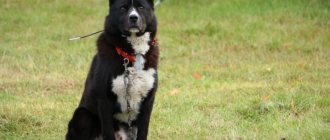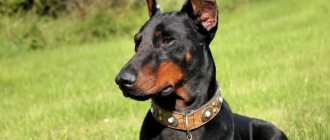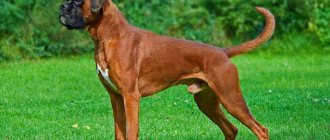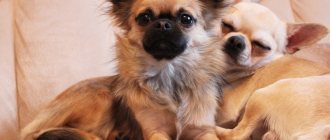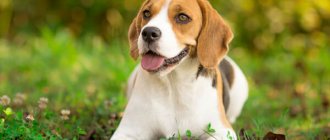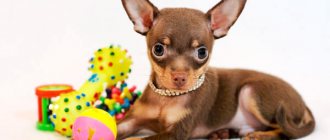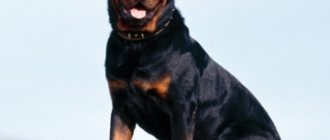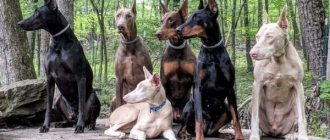History of the origin of the breed
The pedigree of Dobermans began to be tracked only after the dogs began to take part in exhibition shows. The breed was bred only for the purpose of obtaining good performance characteristics. Due to problems with transportation, the offspring were obtained by crossing the first available individuals.
Starting from the middle of the last century, specialists began to work on improving the breed, and the improvement of breed characteristics began to be carried out quite recently. The breed received its name in honor of the Dobermann Friedrich Louis, who, without professional skills, practiced breeding this breed for 25 years. He just needed a strong and loyal dog as he worked as a night policeman and tax collector. Therefore, the basis of my selection work was the goal of obtaining a fairly fearless dog that is easy to train.
Unfortunately, in our time there is completely no information on what breeds of dogs this person used when breeding the breed. At the same time, it is well known that as a result of breeding work, offspring were born that, according to their data, did not correspond to Dobermanns. Therefore, experts agreed that in his work Friedrich used such breeds of dogs as Rottweiler, Weinmaraner, Shepherd Dog, Hound, Pinscher and Great Dane.
As a result of the efforts of Friedrich Dobermann, a strong, athletic and graceful dog was born. It was she who began to resemble the modern breed. After some time, Otto Geller, who ran the Von Thüringen dog kennel in Anold, began to work on the breed’s qualities.
Interesting to know! Dobermans have become so widespread in Europe and other countries thanks to Otto Geller. This breed first appeared on Russian territory only in 1902.
Owner reviews
Nikolay : “When I adopted a Doberman, everyone told me that this breed was not suitable as a “first dog.” What can I say now, three years later. There are no breeds that are suitable or unsuitable for a “first dog”. There are lazy and irresponsible owners. Yes, Thunder has become a huge part of my life. I spend most of my free time with him. Every day I start with a morning jog in the company of my dog and end with an evening walk. Yes, I had to learn the basics of training. Yes, we trained long and hard and are still training. But, for all these efforts, I receive such a huge portion of love and devotion that no one else could give me. I have never regretted my choice."
Tatyana : “When my husband and I decided to adopt a Doberman puppy, our life was divided into two parts. We don't have children and we're used to living for ourselves. With the appearance of this baby in the house, everything turned upside down. Now we live for him! This little dog has become the main member of our family. At first it was very difficult to get up at 6 am and immediately take him outside. Come in at lunchtime and take the dog for a walk instead of lunch. Up to 8 months, wind the ears so that they stand up correctly. My husband and I are already being recognized at the pharmacy where we bought ear patches all this time. The dog constantly needs mental toys; he has to invent something all the time. It's difficult, but very interesting. I urge everyone who, like us, wants to adopt a dog of this breed, to evaluate their strength! Don’t take it thoughtlessly.”
Video review:
Description of the Doberman breed
This is a medium-sized dog breed or slightly above average. Males reach 70 cm in height at the withers (on average), and females are about 5 centimeters less. Although the dog is muscular and strong, it does not look awkward. Modern Dobermans are physically strong animals with strong bones, while they are distinguished by a beautiful silhouette, where short and straight lines predominate. Thanks to such characteristics, this dog is in great demand among breeders all over the world.
The main color of the breed is black or brown, with clearly demarcated rusty-red markings present on some parts of the body. These days, Dobermans can be found in police or military service because they have an excellent sense of smell. As a rule, Dobermans live no more than 15 years.
Breed standards
The Doberman breed, bred in Germany in 1890, according to the ICF classification, is classified in the group of Pinschers, Schnauzers, Molossians and Swiss Cattle Dogs. At number 143 she is in the Pinscher and Schnauzer class. According to breed standards, the dog must have:
- A blunt head, wedge-shaped when viewed from above.
- Flat forehead, with a smooth but clearly visible transition to the muzzle and adjacent lips.
- The teeth are white with a regular scissor bite.
- The medium-sized eyes are dark in color, although lighter-colored individuals may have lighter eye shades.
- The ears are erect, set high. They are docked according to the overall length of the head.
- The neck is dry and muscular, set high.
- High and long withers, well developed.
- A short and strong back, as well as a muscular and slightly arched lumbar region.
- The croup is sloping and fairly wide.
- The chest area is relatively wide, oval in shape, reaching to the elbows.
- Tucked stomach, with a beautiful curved line at the bottom.
Important point! The Doberman's tail is docked at two weeks of age. If previously only four vertebrae were left in the cupping process, today there are even fewer - only a couple of vertebrae or no more than three.
Description of the breed's limbs
The forelimbs of Dobermans are distinguished by the fact that they have vertically directed forearms, while the elbow part is pressed to the chest and is directed strictly back. The wrists are wide and strong, including elastic and short. The forelimbs are quite muscular, dry and prominent.
The hind limbs are also well developed, and are distinguished by the presence of hips, which are equally muscular and wide. The hock joints are strong and dry. The tibiae are relatively long, but of an inclined type. The dog's movements are light and elastic, as well as free and sweeping, and the running of Dobermans is fast, relaxed and very beautiful.
Doberman color
The dog's coat is short and hard with a characteristic shine, while it fits tightly to the body. The main color is black or brown, closer to dark tones. The presence of fairly pronounced rusty-red tan marks is considered a characteristic feature of the breed.
Breed defects
The disadvantages of Dobermans include the following factors:
- Soft and wavy coat.
- The presence of tan marks of a different shade.
- The presence of a thick and pronounced undercoat.
- Amble.
- The hocks are closely spaced, the angulations are irregular, and the presence of dewclaws.
- The elbows are everted, clubfoot.
- Weakly defined muscles.
- The chest area is flat, barrel-shaped or narrow.
- The eyes are bulging and the neck is thick and short.
In some cases, breed defects are manifested in the convexity of the frontal part, the absence of a transition or a sharp transition, a short but heavy head, the presence of cheekbones, the presence of a sharp muzzle, low-set ears, thick lips, etc.
✔ The Doberman became a police breed in the 20th century. Why does this dog have his ears and tail docked?
Health
Dobermans are in good health. Predisposed to the following diseases:
- dysplasia of the elbow and hip joints
- heart rhythm disturbance and dilatation
- cardiomyopathy
- Wobbler syndrome
- osteopathy
- epilepsy
- hypothyroidism
- coagulopathies
- oncological diseases
- gastric volvulus
Preventative measures to protect your Doberman puppy
- To keep your Doberman puppy completely safe, you first need to minimize his contact with unfamiliar dogs, especially homeless ones. Therefore, you should not let your dog off the leash, as in this case it will become impossible to control its behavior and communication with other dogs. Since a dog can easily become infected with distemper from simply touching the nose of a sick animal. This disease can be transmitted to a dog through sniffing. Your dog can become infected with trichophytosis from contact with the lichen-affected fur of a sick dog. Naturally, it is impossible to completely exclude a dog’s communication with other dogs, since it must be socialized. Therefore, try to find friends with dog lovers who look after their animals. By adhering to this rule, you can eliminate the risk of pathogen transmission by 80%.
- You should walk your dog in places where there are no landfills. Since garbage very often attracts rodents, which in turn are very often carriers of various infections. Gray rats are especially dangerous because they carry such a serious disease as leptospirosis.
- You should not allow your dog to sniff other people's feces, as they are a source of worms.
- Monitor your Doberman's health. Pay attention to even the most minor changes in his behavior. For example, your dog may appear lethargic, lose his appetite, or have a dry nose. Or you may notice that the dog begins to shed, and this has nothing to do with seasonal shedding. If hair loss becomes excessive, this is the first symptom indicating health problems in your pet. And only you can help him. Therefore, it is important to take the dog to the veterinary clinic in time, where the disease can be overcome for sure. In no case should you ignore the symptoms, since advanced infections are much more difficult to treat, and sometimes even impossible. If you start treating your dog, the disease can lead to his death or he will develop serious complications that will affect his hearing, vision, limbs and much more.
Character of Dobermans
Many people believe that Doberman dogs are quite angry, cocky and have a completely unbalanced character, although in reality this is not the case. This breed never shows unmotivated aggression towards humans or other animals.
In the 20th century, through the efforts of breeders, work was carried out to correct the character of these animals, although this still requires competent education, otherwise it will not be possible to achieve the appropriate breed characteristics, such as devotion to their owner. Therefore, from a very early age, the animal must be trained so that it becomes accustomed to order and unquestioning obedience.
Doberman intelligence
Dobermans are characterized as smart animals, since they have high intellectual abilities at the genetic level, as well as the skills of a service dog.
Important to remember! To properly raise a dog, you will need a lot of strength and energy, as well as patience.
An adult dog is able to determine the mood of its owner even by the intonation of his voice. The breed has the properties of a guard with high mental abilities.
Aspects of socialization
Modern Dobermans are extremely popular because they are capable of becoming true companion dogs. They quickly become accustomed to their surroundings and enjoy taking part in joint walks with their owner. A properly and competently raised dog is pleasant to talk to and quickly becomes a full member of the family, treating both children and other pets equally well. At the same time, all strangers can pose a threat to this dog (at least, this is how the dog perceives it) and are under constant surveillance by Dobermans.
Dobermans. All about the breed
Photo
Meet the Doberman breed, photos of which are presented in the gallery above. Not a single dog photo turns out bad. It’s as if the Doberman has been studying the art of posing all his life, because in every photo he looks graceful, dignified and elegant.
Interesting facts about the breed:
In Russia, the Doberman was very popular in the 20-40s, it was used as a security guard, demolition worker, sapper, reconnaissance officer, and paratrooper. Gradually, the dog lost its position to the German Shepherd, and all because there were not enough dog handlers in the country capable of training this unique breed.
Not only the Greyhound, St. Bernard, Husky, Tibetan Mastiff, Afghan Hound, but also the Doberman Pinscher appeared in the Guinness Book of Records. He is recognized as the best bloodhound, because a dog named Sauer from South Africa at the beginning of the 20th century was able to track down a thief, despite a distance of 160 km.
Proper maintenance of Dobermans
These dogs are very clean and also have good health. The tail and ears should be docked first. Up to six months, your pet must complete the entire course of vaccination.
Conditions of detention
Since Dobermans have short hair, they do not require frequent brushing. Despite this, every day the dog needs to be wiped with a damp cloth, followed by combing with a stiff brush. Water procedures are considered hygienic measures, and the animal should be bathed no more than 2 times a year. After walking outside, it is better for your pet to wash its paws.
Important stage! The condition of the Doberman's eyes and ears should be monitored regularly.
For this purpose, they are periodically wiped with damp cotton swabs. It is equally important to trim the claws in a timely manner, as well as replace the bedding. In the warm season, daily walks should be at least two and a half hours. In winter, since the dog does not have a warm undercoat, you should put on warm overalls before going for a walk.
What to feed Dobermans
There are 2 options for feeding your pet: special store-bought food or natural products. In any case, you should adhere to a number of rules:
- Pets weighing up to 24 kg can be fed with purchased high-quality food rations.
- For dogs weighing 25 kg or more, food from a dietary group is suitable to minimize the likelihood of obesity.
- Older dogs are fed dry food softened in kefir.
In the case of using natural feed, the basis of the diet should be meat components. A healthy and active dog needs up to 1 kg of lean meat every day. At the same time, Dobermans should not be given fatty meat, minced meat, or offal. In addition to meat, the daily diet should include fermented milk products, porridge based on barley or semolina. Vegetables in the form of zucchini, carrots and cabbage also do not hurt.
Dobermans: care and maintenance
Features of care
Doberman Pinschers require minimal grooming. Once a week they need to be brushed with a brush for short-haired dogs, and during the shedding period this will have to be done a little more often: 2-3 times a week.
These dogs should be bathed no more often than once every 4-5 months, using special shampoos for animals.
Eyes, ears and teeth should be examined daily and, if signs of contamination appear, promptly cleaned. Dobermans rarely have their nails trimmed, since these dogs usually walk a lot on hard surfaces and grind them down themselves.
We must not forget that the Doberman needs timely deworming and vaccinations; it is also necessary to treat the dog with a flea and tick remedy for preventative purposes..
Buying tips and advice
Firstly, you should decide why such a dog is needed and only then make the decision to buy a puppy of this breed. In any case, you should ask about his pedigree, although even having all the documents does not guarantee that you will be able to get a puppy with excellent characteristics. It should be noted that the chances of acquiring a cowardly or aggressive animal are much less. Before 2 months of age, it is unlikely that a puppy will be separated from its mother.
It should be remembered that females are more gentle and affectionate, but males have a better developed protective instinct. As a rule, experienced breeders sell animals with cropped ears and tails. A purebred and healthy puppy should not have breed defects. It is imperative to check the abdominal area so that the puppy does not have an umbilical hernia. It is mandatory to draw up a purchase and sale agreement, with the possibility of returning the puppy to the kennel in case of any negative manifestations. If a puppy is purchased from a nursery with all accompanying documents, then its cost starts from 36 thousand rubles.
Prices
How much does a Doberman cost? The cost of puppies depends on their class, the pricing policy of the nursery and the geographical location of the breeder. Through private advertisements, you can buy a Doberman for an average of 8 thousand rubles; the availability of documents for the puppy, of course, is out of the question.
Despite the large number of nurseries and the popularity of the Doberman breed, the price for them is quite high. If you decide to purchase a puppy with all the necessary documentation, you will have to focus on price tags from 15 to 50 thousand rubles.
Pet-class puppies, not allowed for breeding, and for some reason unable to participate in exhibitions, cost from 15 to 23 thousand rubles.
Representatives of the breeding class, who are predicted to have a breeding and exhibition future, cost from 24 to 35 thousand rubles. Show class can be purchased for a price of more than 35 thousand rubles.
How to feed?
These dogs can be fed either high-quality ready-made food or nutritious home-cooked food.
If you decide to feed the Doberman with natural food, then you need to ensure that the amount of meat and other protein products in its diet is at least 50%.
It is necessary to include fermented milk products in the food, such as kefir, natural yogurt and cottage cheese, vegetables, fruits and herbs.
Also, with natural feeding, you cannot do without vitamin and mineral supplements to food.
Ready-made food is selected according to the weight, size, physical condition and age of the dog.
How to choose a puppy?
You should only buy a Doberman from a nursery or a breeder. In this case, it is advisable to focus on how healthy and conformable his parents are. It is also necessary that the dogs of the selected line have a stable psyche and do not experience increased aggressiveness.
Puppies must be completely healthy and meet conformation requirements. They should have a square body or something close to it, strong bones, a fairly deep and wide chest, large paws with the makings of muscles. Color: brown or black with intense reddish-red tan markings.
NOTE!
If small Dobermans have had their tails docked, then by this time the wounds should be completely healed.
New owners, as a rule, crop their ears themselves, but if a puppy is sold with ears already cropped, then the stitches should already be removed and the cut should look healed.

